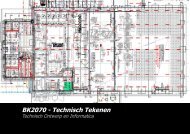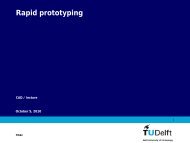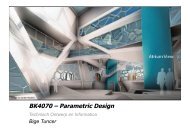Perception Aspects in Underground Spaces using ... - TOI - TU Delft
Perception Aspects in Underground Spaces using ... - TOI - TU Delft
Perception Aspects in Underground Spaces using ... - TOI - TU Delft
You also want an ePaper? Increase the reach of your titles
YUMPU automatically turns print PDFs into web optimized ePapers that Google loves.
ContentsChapter 1 Introduction 11.1. Background and research problem . . . . . . . . . . . . . . . . . . . 11.2. Research objectives . . . . . . . . . . . . . . . . . . . . . . . . . . 31.3. Method . . . . . . . . . . . . . . . . . . . . . . . . . . . . . . . . 41.4. Outl<strong>in</strong>e of the thesis . . . . . . . . . . . . . . . . . . . . . . . . . . 6Chapter 2 From spatial plan<strong>in</strong>g to perception of space 92.1. Introduction . . . . . . . . . . . . . . . . . . . . . . . . . . . . . . 92.2. <strong>Underground</strong> space and multiple space usage . . . . . . . . . . . . . 92.3. ICT development and <strong>in</strong>fluence on spatial plann<strong>in</strong>g . . . . . . . . . . 122.4. Architectural design data and the role of ICT <strong>in</strong> design . . . . . . . . 142.5. Architects and the end users . . . . . . . . . . . . . . . . . . . . . . 152.6. Exist<strong>in</strong>g models for public safety. . . . . . . . . . . . . . . . . . . . 182.7. Human be<strong>in</strong>g, built environment and social context . . . . . . . . . . 192.8. Environmental psychology and sociology . . . . . . . . . . . . . . 20Chapter 3 Identification of the model parameters 253.1. Introduction . . . . . . . . . . . . . . . . . . . . . . . . . . . . . . 253.2. The variables for an assessment of spatial experience -Research variables . . . . . . . . . . . . . . . . . . . . . . . . . . . 253.2.1. Dependent variables: determ<strong>in</strong>ants of comfort and safety . . . 263.2.2. Independent variables: spatial characteristics and context . . 363.2.3. Interven<strong>in</strong>g variables: <strong>in</strong>dividual characteristics . . . . . . . 433.3. The variables for an assessment of spatial experience -Procedural variables . . . . . . . . . . . . . . . . . . . . . . . . . . 443.3.1. Presentation and response method . . . . . . . . . . . . . . 443.3.2. Reliability and validity . . . . . . . . . . . . . . . . . . . . 453.4. Conceptual framework . . . . . . . . . . . . . . . . . . . . . . . . 46Chapter 4 Theoretical background on soft comput<strong>in</strong>g 474.1. Introduction . . . . . . . . . . . . . . . . . . . . . . . . . . . . . . 474.2. Traditional methods for data analysis . . . . . . . . . . . . . . . . . 47





